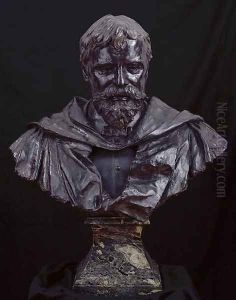Edward Onslow Ford Paintings
Edward Onslow Ford was a prominent British sculptor of the late 19th century, whose work epitomizes the aesthetic and technical shifts that characterized the period. Born on July 27, 1852, in Islington, London, Ford's early life was marked by a cosmopolitan upbringing due to his family's relocation to Antwerp and then to Blackheath, London. This exposure to different cultures and artistic traditions would later influence his eclectic style. He initially studied painting but soon discovered his true passion lay in sculpture, which led him to pursue further studies at the Koninklijke Academie voor Schone Kunsten in Antwerp, Belgium.
Ford's career began to flourish upon his return to England in the late 1870s, where he became a pivotal figure in the New Sculpture movement. This movement sought to revitalize British sculpture by infusing it with a sense of dynamism, emotion, and naturalism, moving away from the rigid neoclassicism that had dominated the field. Ford's sculptures from this period, characterized by their intricate detail, innovative use of materials, and expressive qualities, garnered critical acclaim and established him as a leading sculptor of his time.
Among Ford's most notable works are the monument to Percy Bysshe Shelley in University College, Oxford, and the Jubilee Memorial to Queen Victoria in Manchester, which showcase his ability to blend classical elements with contemporary realism. His statues and busts, often of notable figures of his era, demonstrate a keen psychological insight and a mastery of form and texture. Ford was also renowned for his allegorical figures, which combined a Pre-Raphaelite sensuality with Symbolist overtones, reflecting the broader artistic trends of the late 19th century.
Edward Onslow Ford's contributions to British sculpture were widely recognized during his lifetime. He was a key member of the Royal Academy and received numerous commissions from both private clients and public institutions. His work influenced a generation of sculptors and helped to redefine the possibilities of the medium. Ford's sudden death on December 23, 1901, in London, at the age of 49, marked the end of a prolific career that had a lasting impact on the development of modern sculpture. His legacy is preserved in the collections of major museums and public spaces, continuing to inspire and captivate audiences with its beauty and innovation.

